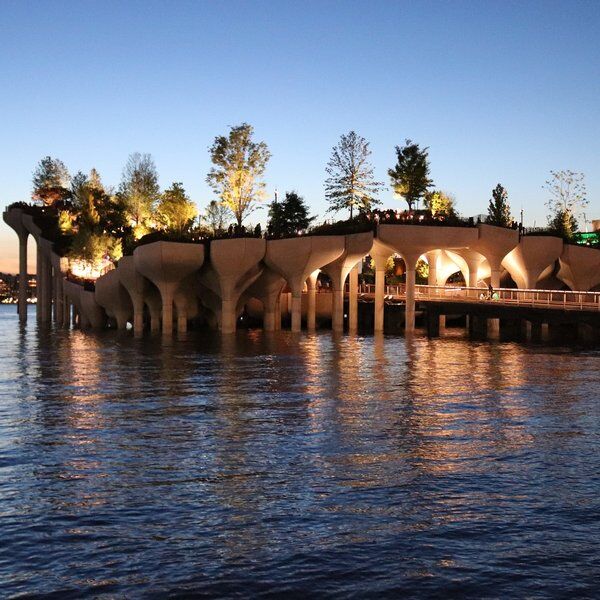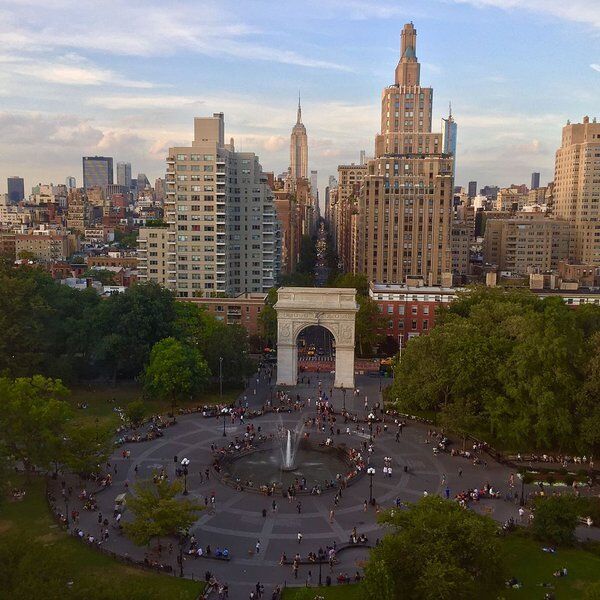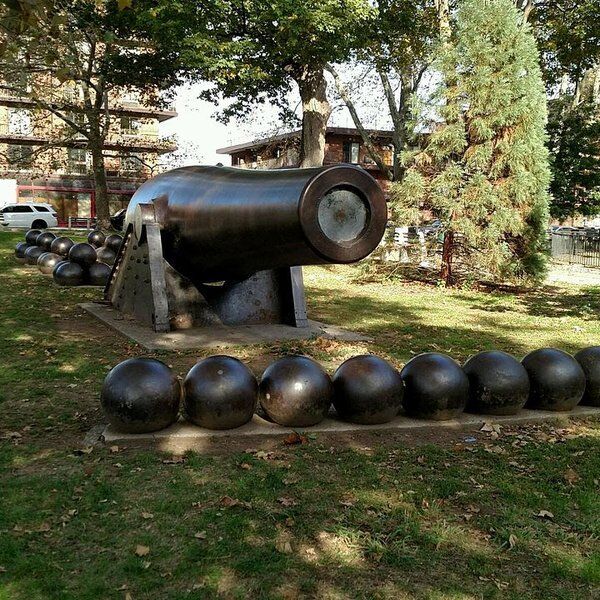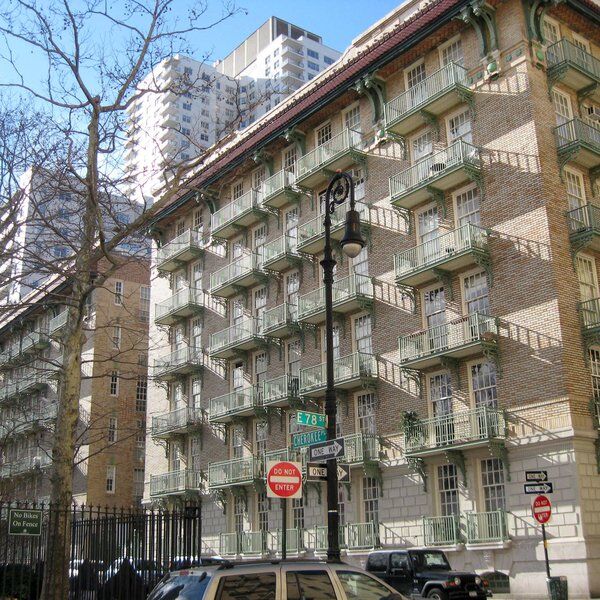Bannerman Castle in Hudson Valley
Perched majestically atop Pollepel Island, a 6.5-acre uninhabited piece of land in the midst of the Hudson River, lies Bannerman Castle. Often mistaken for a crumbling Scottish Castle, this dilapidated structure was actually a military surplus warehouse. Pollepel Island, its name deriving from the Dutch word "Pollepel," meaning "(pot) ladle," has captured the curiosity of anyone looking over from the shores of Newburgh, Beacon, or Cornwall-on-Hudson.
Today it is possible to book a tour to visit the island and its derelict Bannerman Castle. The tours commence with a 30-minute boat ride departing from Beacon, New York, conveniently located adjacent to the community's train station. Whether arriving by car or taking the Metro-North Railroad's Hudson Line from Grand Central Station in New York City (just 1 hour and 40 minutes away), access to these tours is easily accessible for all adventurers.

The Origins of Pollepel Island
Situated about 50 miles north of New York City, with its eastern bank just 1,000 feet away, Pollepel Island is predominantly rocky terrain. Over the years, it has been referred to by various names, including Pollopel Island and Bannerman's Island. Its historical significance dates back to the first navigation of the Hudson River by early Dutch settlers, serving as a strategic point during the Revolutionary War.
Despite attempts to obstruct British passage, Pollepel Island did not deter a British flotilla from raiding Kingston in 1777. General George Washington once considered utilising the island as a military prison, although no such facility was ever constructed.
The Legacy of Francis Bannerman
Early Life
Francis Bannerman, born in Dundee, Scotland in 1851, migrated to the United States with his family when he was three years old. Growing up in Brooklyn, New York, Bannerman would scavenge scrap metal from the harbour after school and sell it on, displaying an early aptitude for business. In 1865, aged 14, he boldly opened his own business, Bannerman’s, specialising in the sale of military surplus goods.
From here Bannerman’s business rapidly expanded from dealing in scrap metal to purchasing entire ships at Navy auctions. His inventory included a lot of historical artefacts, including cannons from pivotal battles like Yorktown, pristine Civil War uniforms, and relics from Admiral Perry’s Arctic expedition.
Bannerman's clientele spanned diverse sectors, from the burgeoning American film industry to military outfits seeking surplus supplies. Astoundingly, it's estimated that Bannerman's was responsible for around half of the commemorative cannons found in public spaces across the United States.
Beyond his business ventures, Bannerman contributed generously to charitable causes, including donations to support the US government during World War I.
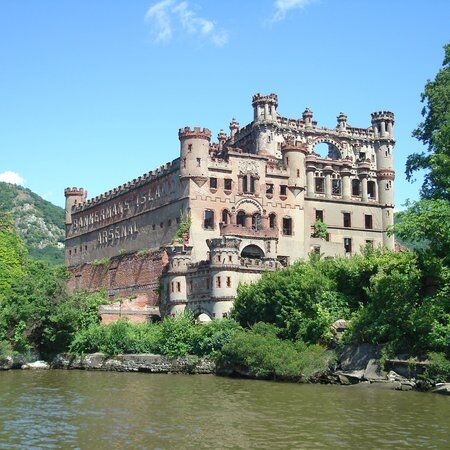
Creating Bannerman's Castle
Driven by ambition, Bannerman capitalised on his success by acquiring a staggering 90% of US army surplus following the Spanish-American War. However, this presented a challenge; where would everything be stored?
The solution was stumbled upon by his son David, who encountered Pollepel Island while canoeing on the Hudson River. In 1900, the family seized the opportunity, purchasing the island for use as a secure storage facility.
Construction on a distinctive Scottish-style castle and accompanying residence, envisioned by Bannerman himself, commenced in 1901. This residence served as a summer retreat for the Bannerman family, with Mrs. Bannerman tidying up the surroundings with her gardening prowess.
Characterised by its imposing stone walls, crenellated towers, and whimsical turrets, Bannerman Castle’s architecture is rather elaborate. This is partly due to the fact that whilst Bannerman provided the designs, the actual construction was mostly carried out without professional oversight, allowing the builders to interpret the plans creatively.
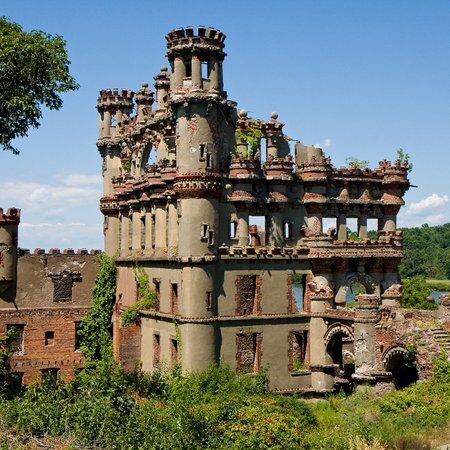
The Decline of Bannerman Castle
Following Francis Bannerman's passing in 1918, significant changes swept over Bannerman Castle in New York. A tragic explosion in 1920 caused substantial damage to the structure, leading to years of neglect and gradual deterioration.
By the early 1950s, the island was permanently abandoned. In 1967, the state acquired the island, intending to transform it into a state park. However, a massive fire in 1969, coupled with the deteriorating condition of the structures, led to further neglect.
In December 2009, approximately 30-40% of the castle’s front wall and half of the east wall collapsed. While some exterior walls endure, internal floors and non-structural walls have succumbed to time. The island also suffered from vandalism, trespassing, and tragedies, such as the drowning of Vincent Viafore, in 2015, during a kayak trip.
Preservation and Revival
Despite these challenges, preservation efforts persisted. Since the early 1990s, The Bannerman Castle Trust, Inc., a non-profit organisation, has dedicated itself to preserving the cultural and historical significance of Bannerman Castle in New York. In 2021, it assumed responsibility for the island's care.
Through fundraising efforts and by collaborating with the New York State Office of Parks, Recreation, and Historical Preservation, the Trust aims to gather resources necessary for the restoration, maintenance, and preservation of the island's structures and trails.
The Trust’s overarching goal is to make the Bannerman Castle structurally safe, raise awareness of its historical significance, and promote it as a cultural and recreational destination in the Hudson Valley.

Exploring Bannerman Castle Today
In order to achieve their goals the Trust encourages the public to participate in various activities held on the island, from performances and events to guided tours. Every interaction means more revenue and funding for Bannerman Castle’s restoration.
Guided Tours
Accessible via the Estuary Steward, a small 30-minute boat trip takes visitors over the 3.5-mile stretch of water, to the island. En route, passengers are given snippets of local history and important landmarks, such as George Washington’s Headquarters and Dennings Point in Beacon and Newburgh, are pointed out.
Upon arrival, guided tours commence from the island's summit, accessible via approximately 70 steps from the dock. Delving into the island's history, from its occupation by Native Americans and Dutch sailors to its strategic use by the Continental Army, the tours provide insight into its transformation since Francis Bannerman’s acquisition in 1900.
Guided tours typically last 60 minutes, with 30 minutes for independent exploration. A network of trails meanders through the island, leading to panoramic viewpoints showcasing the castle and the Hudson River, complemented by remnants of Francis’ wife’s handiwork in the gardens.

Discover More of New York with CityDays
Discover New York’s secret sites and noteworthy nooks by playing one of our New York treasure and scavenger hunts, escape room games or walking tours.
You’ll find curated trails and hunts all over New York, including Manhattan, Chelsea, Midtown and Chinatown.
All you have to do is team up with your friends, family or whoever to solve riddles, complete challenges and answer trivia to lead you on an unforgettable journey around New York’s most intriguing streets.
The best part? We’ll recommend top-rated bars, cafés and restaurants and give your team the chance to earn rewards by competing on our leaderboard.
CityDays gives you total freedom to start and finish whenever you like, take extra breaks if you want or need them, and it’s suitable for people of all ages.
You’re also guaranteed your money back if you don’t have an amazing time - although our previous reviews speak for themselves: we’re rated 5/5 on TripAdvisor and 4.95/5on Google Reviews!




